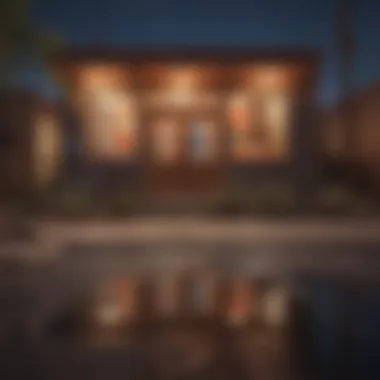Discovering Arizona's Unique Neighborhoods and Communities


Intro
Arizona, known for its undulating landscapes and cultural richness, houses a myriad of neighborhoods each with their own distinct flavor. The versatile offering makes it a haven for anyone from real estate investors to travel enthusiasts and those with an eye for interior design. Whether you're drawn to bustling city life or the quiet embrace of suburban realms, Arizona has it all. Delving into its diverse locales not only reveals the architectural splendor but also exposes the soul of its communities - the people, their stories, and the lifestyles they lead.
As we embark on this exploration, we aim to paint a vivid picture that gives voice to each neighborhood's unique characteristics. From housing markets to recreational options, understanding these neighborhoods is more crucial than ever for potential movers and investors alike.
In this guide, we'll traverse through neighborhoods that range from upscale areas with lavish properties to those that boast serene retreats, each presenting its own lifestyle offerings. Let's delve deeper into what makes Arizona an increasingly attractive destination.
Inspiring Homes
In the heart of Arizona, neighborhoods come alive through their architectural diversity and stunning residences. Each home showcases not just luxury, but also the identity of the community it belongs to.
Luxury Properties
Luxury living in Arizona is epitomized by the breathtaking estates in places like Scottsdale. Here, mansions with sprawling grounds and opulent interiors stand as a testament to modern living. The desert landscape serves as a perfect backdrop for lavish swimming pools and immaculate gardens that create a private oasis. Some of the notable properties in Scottsdale include those with smart-home technology and eco-friendly designs, which blend luxury with sustainability.
Cozy Retreats
For those seeking warmth, neighborhoods like Flagstaff present charming cottages that exude coziness. Nestled among pine trees, these homes offer a rustic yet modern aesthetic. Picture yourself unwinding in a cabin-type property after a day of outdoor adventures. Many of these retreats embrace the indoor-outdoor living trend, making the most of Arizona’s favorable climate by incorporating large windows and spacious decks.
Unique Architectural Styles
Unique architectural expressions can be found enveloped in the rich history of neighborhoods such as Prescott or Tucson. The adobe-style homes that line the streets tell tales of Arizona’s rich cultural heritage. You'll also find innovative modern designs that adopt local materials and sustainability frameworks. This mix of old and new keeps the Arizona neighborhoods vibrant and alive, showcasing how home designs can be a confluence of various influences.
Real Estate Market Insights
As the charm of its neighborhoods continues to pull in buyers, understanding the real estate market becomes paramount.
Market Trends
The Arizona real estate market has seen notable shifts recently. Cities like Phoenix have experienced a boom in housing demand, attracting those from more expensive states. As demand surges, we also find an increase in new constructions and revitalization of existing properties. Information on current trends can often be found in local market reports that detail fluctuations in property values and buyer preferences.
Investment Opportunities
For investors, neighborhoods such as Mesa show potential for substantial ROI. With developing infrastructure and a growing population, these areas are becoming increasingly attractive for rental properties and long-term investments. Picking the right locale can significantly affect your profit margins—thus careful analysis and local insights are necessary for success.
Buying Guides
Navigating the Arizona real estate market can be daunting yet rewarding. Prospective buyers should consider a few vital steps:
- Research the Neighborhood: Understand the local amenities and demographics.
- Engage with Local Real Estate Agents: They can offer tailored advice that matches your needs.
- Inspect Properties Closely: Always ensure to check for quality and value.
Purchasing a home or investing in real estate in Arizona isn’t just about the structure; it’s about the lifestyle that comes with it. With each neighborhood offering its unique blend of charm and character, it’s crucial to explore thoroughly before making a decision.
End
In summary, exploring the neighborhoods in Arizona paints a vivid picture of life that is as diverse as the state itself. With a balanced blend of luxury, coziness, and unique architectural styles, Arizona beckons residents and investors alike. As you navigate these vibrant streets, you'll find not just houses but homes, promising not only shelter but a place where stories unfold—a tapestry woven from the threads of community, culture, and history.
Prelude to Arizona Neighborhoods
Arizona, a state rich in culture and diversity, unfurls a tapestry of neighborhoods that reflect its unique heritage and vibrant lifestyle. Each community offers something distinct, whether it's the warm embrace of suburban life or the bustling energy of urban settings. Understanding these neighborhoods is crucial not only for potential homeowners and real estate enthusiasts but also for anyone looking to fully grasp what makes Arizona a desirable place to live.
The importance of exploring Arizona neighborhoods lies in their ability to enlighten potential residents about the character of each area. For instance, the contrast between Scottsdale’s luxury and Tempe’s youthful vibe is palpable. Those seeking a family-oriented environment are welcomed in Chandler, while adventure lovers may find solace in the scenic landscapes of Sedona. It’s like trying to choose your favorite flavor of ice cream; each has its nuances and appeal, catering to different tastes and preferences.
Additionally, neighborhoods in Arizona are often shaped by their demographics and cultural backgrounds. The influx of newcomers over the years, along with established local traditions, creates a blend of influences that make each locality unique. For instance, the population in Gilbert is seen to favor family-oriented events while also embracing the growing trend of outdoor activities that appeal to a broader audience. This diversity in culture not only enriches the communities but also provides residents with varied experiences.
Here are a few key elements to consider when exploring Arizona neighborhoods:
- Community Resources: Access to parks, schools, and recreational facilities greatly influences neighborhood appeal.
- Economic Growth: Areas experiencing significant business development often attract a young, vibrant population.
- Cultural Activities: Festivals, art shows, and local markets contribute to the community spirit.
In summary, diving into the neighborhoods of Arizona offers insights that go beyond mere geography. It’s about understanding the soul of a place, where one can both find a home and embrace a lifestyle that suits their needs. Whether you’re considering buying property or just curious about life in this sunny state, grasping the essence of Arizona's locales will serve as an invaluable guide.
Historical Overview
Understanding the history of Arizona's neighborhoods offers a valuable perspective on their current character and dynamics. This historical overview provides essential context on how communities evolved and how past trends continue to influence the present demographic fabric. The interplay of culture, governance, and the environment has sculpted these neighborhoods into distinct entities. Recognizing this evolution helps residents and potential movers alike appreciate not only the aesthetic aspects of these locales but also their deeper roots and implications for the future.
Evolution of Arizona Communities
The evolution of Arizona communities echoes the story of resilience and adaptation. Early inhabitants were primarily Native American tribes, such as the Hopi and Navajo, who built rich, intricate societies. The arrival of European settlers in the mid-19th century marked a seismic shift. Towns sprouted in response to the influx of diverse populations and resources—mining, agriculture, and the railroad played pivotal roles. These areas shifted from temporary mining camps to permanent settlements, each adding layers of history and culture.
In recent decades, with the booming real estate market, especially in cities like Phoenix and Scottsdale, old neighborhoods have transformed dramatically. Historic homes are being restored and repurposed, while others have given way to contemporary developments. The tension between preserving the past and embracing the new highlights an ongoing debate among long-time residents and newcomers alike.
Influential Events Shaping Neighborhoods
Certain key events stand out as particularly influential in shaping Arizona's neighborhoods. The 1912 statehood was a turning point, igniting an era of growth and civic identity. Urban centers began to flourish, driven by agricultural fortune and new industries. The post-World War II boom further changed the landscape as returning veterans sought housing—suburbs grew, offering families more spacious living arrangements.


More recently, natural events like the monsoon storms have also played significant roles. The flooding of specific neighborhoods led to new infrastructure developments, reshaping community layouts. Additionally, cultural events such as the annual Arizona State Fair or local art festivals have fostered closer community ties and pride. Each event, whether catastrophic or celebratory, carved new paths through the neighborhoods, influencing everything from socio-economic structures to zoning laws.
"Historical events shaped the very fabric of our neighborhoods, intertwining stories and struggles, innovation and tradition."
By looking at the historical overview of communities, one can see the rich tapestry that makes up Arizona's neighborhoods. This knowledge equips potential residents and investors with a more profound understanding of the areas they might call home. From historical landmarks in neighborhoods to stories passed down through generations, these insights offer a nuanced perspective that enriches the overall experience of living in Arizona.
Urban Neighborhoods in Arizona
Urban neighborhoods in Arizona are often the vibrant backbone of the state's cultural and economic life. These areas are more than just places to live; they are hubs of activity and interaction. When you think about urban living, especially in Arizona, think of a melting pot where diversity thrives, art flourishes, and opportunities abound. Exploring these neighborhoods helps us understand not only the unique characteristics of each area but also the factors that enhance the livability and attractiveness of urban environments in Arizona.
Phoenix’s Downtown Scene
Downtown Phoenix is a testament to how a city can grow and evolve over time. Previously overshadowed by its more glamorous neighbors, it has emerged as a bustling center of art, culture, and commerce. Here, skyscrapers loom, creating a skyline that's almost dramatic against the backdrop of the desert. The light rail system connects various parts of the city, making commuting seamless and affordable.
Key highlights include:
- Cultural Institutions: The Phoenix Art Museum and the Heard Museum attract both locals and visitors, showcasing regional art and Native American heritage.
- Dining Options: You'll find a spectrum from food trucks offering authentic tacos to high-end restaurants serving gourmet dishes.
- Nightlife: The nightlife scene is electric, with bars and live music venues thriving in the area, making it a great spot for socializing.
The dynamic atmosphere in Downtown Phoenix caters not only to professionals but also to families and retirees, offering a rich blend of experiences.
Tempe: A College Town Vibe
Tempe brings its own charm with Arizona State University nestled right in its heart. The youthful energy is palpable, and it’s not just the students who enjoy what Tempe has to offer. The area is renowned for its walkability, making it easy to explore its coffee shops, boutiques, and parks. The site of events like the annual Tempe Festival of the Arts draws crowds from all over, celebrating local artists and creators.
Benefits of living here include:
- Educational Opportunities: Tempe is a hub for learning, with many resources available from the university, such as public lectures and art exhibits.
- Outdoor Activities: The nearby Tempe Town Lake provides options for kayaking and picnicking, promoting an active lifestyle.
- Community Engagement: Residents often partake in various volunteer efforts, fostering a strong sense of community.
The college atmosphere contributes not just to the vibrancy, but also to a sense of youthfulness that makes Tempe appealing for all ages.
Scottsdale: The Heart of Luxury
Scottsdale stands out as a beacon of luxury living in Arizona. Known for its upscale resorts and spas, it is a prime destination for those who appreciate an affluent lifestyle. Beyond the lavishness, it offers an artistic flare with its art galleries and sculpture parks. The famous Scottsdale Waterfront is a picturesque area where residents can enjoy the beauty of the desert landscape while indulging in high-end shopping.
Important features of Scottsdale include:
- High-End Shopping: The Scottsdale Waterfront and Scottsdale Quarter are home to designer boutiques, making it a shopper's paradise.
- Gourmet Dining: World-class restaurants dot the landscape, offering cuisines from around the world.
- Wellness Options: With numerous wellness retreats and spas, the focus on self-care is exceedingly high.
Living in Scottsdale means embracing a lifestyle that values beauty, comfort, and a touch of opulence, drawing individuals who are looking for more than just a place to stay.
"Urban neighborhoods aren’t merely about buildings and streets; they represent the evolving spirit and culture of a community, and in Arizona, these neighborhoods illustrate that thriving identity beautifully."
In sum, urban neighborhoods in Arizona present various experiences and lifestyles that cater to different demographics. The energy of Phoenix, the youthful vibe of Tempe, and the luxurious lifestyle found in Scottsdale all represent what urban living in this state can offer. Exploring these neighborhoods can awaken an appreciation for the unique characteristics that make Arizona an integral part of American urban landscapes.
Suburban Communities
Suburban communities in Arizona provide a critical counterbalance to the bustling urban environments found in cities like Phoenix and Tucson. These areas often blend leisure, family-friendly amenities, and a sense of community, making them appealing for various demographics, particularly families, retirees, and young professionals seeking a quieter lifestyle without straying too far from city conveniences. The growth of suburban areas has been significant in the past decades, driven by several factors, including urban sprawl, affordable housing, and the desire for a more connected community experience.
- Key Benefits of Suburban Living:
- Space and Affordability: Suburbs typically offer larger homes and yards at a more reasonable price compared to urban areas.
- Community Feel: Many suburban neighborhoods host events that promote community bonding, from farmers’ markets to neighborhood outings.
- Access to Quality Schools: Suburban areas often invest more in their educational institutions, appealing to families with school-aged children.
In addition to these benefits, suburban areas often highlight nature with parks, walking trails, and family-friendly recreation spots, allowing residents to enjoy outdoor activities without the constant hustle of urban life.
Chandler: A Family-Friendly Locale
Chandler stands out as a prime example of a family-friendly community within Arizona’s suburbs. It boasts a robust system of parks and recreational facilities that cater to families. The vibrant downtown area features shopping, dining, and cultural events. Parents often appreciate the strong school districts, such as the Chandler Unified School District, known for quality education and varied extracurricular activities.
In Chandler, one can find a wealth of amenities including:
- Various community events throughout the year, like the annual Ostrich Festival.
- Several parks that include expansive play areas, splash pads, and picnic facilities.
- A focus on enhancing neighborhood safety and walkability.
The community-centric approach helps foster a strong bond among residents, making Chandler feel like a close-knit family.
Gilbert: Parks and Community Life
Next up is Gilbert, a suburb recognized for its abundant green spaces and commitment to community life. It consistently ranks as one of the best places to live in Arizona, noted for its safe neighborhoods and a plethora of parks. Families flock to Gilbert, particularly drawn by the friendly atmosphere and the plentiful recreational options available.
Some highlights of Gilbert include:
- Heritage District: Renowned for its charming mix of shops, restaurants, and cultural experiences.
- Freestone Park: This large park features a lake, sporting facilities, and numerous playgrounds, attracting families and fitness enthusiasts alike.
- Community Events: Various family-friendly events like farmer's markets and seasonal festivals make Gilbert a lively place to live.
The town demonstrates how suburban living can thrive alongside nature and community, providing a perfect balance for its residents.
Peoria: Balancing Nature and Growth


Peoria represents a more unique take on suburban life in Arizona, blending rapid growth with an intrinsic respect for nature. Nestled near the stunning Lake Pleasant, which offers boating, fishing, and hiking opportunities, Peoria manages to maintain its appeal even as new developments spring up. This suburb attracts those who want the conveniences of urban living without sacrificing their connection to nature.
Consider noteworthy aspects of Peoria:
- Lake Pleasant Regional Park: A great outdoor spot for water sports and nature trails, perfect for families who enjoy outdoor activities.
- Urban Amenities: Peoria boasts modern shopping centers and dining establishments, keeping residents engaged with urban convenience.
- Community Parks: Numerous parks spread throughout the city cultivate social interaction and fitness opportunities for families and individuals.
Peoria's unique melding of urban development with nature positions it as a landscape that is continually evolving, yet grounded in community values.
Peoria’s strategy to expand while preserving green space showcases how modern suburban life can enhance the quality of living for its residents.
Rural and Semi-Rural Neighborhoods
The rural and semi-rural neighborhoods of Arizona hold a unique significance in the broader context of the state’s living environments. These areas represent a blend of natural beauty, peaceful living, and the charm of close-knit communities. Living in these neighborhoods provides residents with a sense of escape from the bustling city life while still being within reach of urban amenities. It's important to recognize the specific elements and benefits that rural living offers.
Rural neighborhoods often feature larger properties, giving residents the chance to enjoy outdoor spaces, gardening, or simply the serenity of less crowded areas. They cater to those seeking a lifestyle that embraces nature, tranquility, and a slower pace of life. Furthermore, semi-rural areas can offer a compromise, providing the feel of the countryside with better access to essential services, schools, and shops.
Sedona: A Scenic Retreat
Sedona is a showcase of natural splendor, often regarded as a hidden gem in Arizona. Surrounded by stunning red rock formations, this area is not just a feast for the eyes but also offers a plethora of outdoor activities. Sedona attracts artists, wellness seekers, and those who appreciate an active lifestyle.
The community is centered around nature and wellness, with numerous hiking trails, mountain biking routes, and spiritual retreats. Local shops and restaurants often reflect the artistic vibe of the area, offering handcrafted goods and locally sourced cuisines. Residents value the sense of community, often participating in cultural events or art festivals. Sedona’s appeal extends beyond its visual allure; it’s a place where residents foster connections and engage in healthy lifestyles.
"In Sedona, every sunrise is a canvas painted with the colors of nature, reminding us of the beauty that surrounds us."
Flagstaff: Mountain Living
Flagstaff stands proudly at a higher elevation, making it a prime location for mountain living enthusiasts. This town is characterized by its cool climate, dense pine forests, and a vibrant college town atmosphere due to Northern Arizona University. Flagstaff is not only attractive for its scenic beauty but also for its strong sense of community and rich history.
People who choose Flagstaff enjoy four distinct seasons, offering varied outdoor activities throughout the year, from skiing in winter to hiking in summer. The local community thrives on its educational resources, cultural events, and access to nature—just a stone's throw from the Grand Canyon. Flagstaff’s neighborhoods often reflect an appreciation for sustainable living, with many residents advocating for environmental conservation.
Cottonwood: Tucked Away Comfort
Cottonwood, a charming small town with a relaxed vibe, serves as a gateway to the Verde Valley. This town might be considered a quieter choice compared to its neighbors, offering a perfect scenario for those looking to escape urban intensity. Known for its historic downtown, Cottonwood has gradually evolved while still maintaining its small-town warmth.
The community is known for its wineries and agricultural offerings, with residents often enjoying wine tastings or local farmers’ markets. Cottonwood provides a blend of affordable housing and a welcoming environment for families and retirees alike. Activities here revolve around community gatherings, local events like art walks, and outdoor festivals, enriching the overall lifestyle.
In summary, the rural and semi-rural neighborhoods in Arizona each bring something unique to the table. They strike a balance between natural beauty and community spirit, offering diverse lifestyles for those who cherish the outdoors and seek connection with their surroundings.
Demographic Trends in Arizona Neighborhoods
Understanding the demographic trends in Arizona neighborhoods is crucial for anyone considering making this state their home or investing in real estate. These trends provide a window into the shifts in population, culture, and economic opportunity that shape communities.
When we talk about demographic trends, we are not just looking at numbers on a page. These trends tell a story about how neighborhoods evolve, what amenities are prioritized, and how communities can adapt to the changing needs of their residents. For potential buyers or renters, understanding these patterns can inform their decisions, helping them choose a locale that not only meets their needs but also offers a supportive environment for their lifestyle.
In essence, demographic trends are like a compass. They guide prospective residents or investors towards areas that are likely to see growth, which is particularly important in a diverse state like Arizona. Now let’s dive deeper into the specifics of these trends.
Population Growth Patterns
Population growth patterns in Arizona paint a vivid picture of migration, economic opportunities, and lifestyle changes. Over recent years, cities such as Phoenix and Tucson have experienced substantial population increases, often driven by factors like job availability and climate appeal. The job market influences where people choose to live, as they flock to areas promising stable employment and career growth.
Several key aspects characterize these population trends:
- Migration from Other States: Many individuals relocating from northern states seek warmth and a lower cost of living, which give rise to these new communities.
- Age Demographics: Arizona is not just home to retirees. Younger families and professionals are increasingly making their mark, especially in urban areas where amenities for younger populations are more abundant.
- Urban vs. Rural Growth: While urban centers are thriving, smaller towns also see growth as they offer a quieter lifestyle. This dual growth creates a fascinating dynamic where both urban vibrancy and rural tranquility coexist.
"Understanding the population dynamics is key for anyone contemplating a move to Arizona. The state's neighborhoods offer a rich tapestry of options, reflecting an ongoing evolution that appeals to varied lifestyles."
Cultural Diversity in Communities
Cultural diversity is an essential aspect of Arizona’s neighborhoods, enriching the social fabric and atmosphere. With a mix of Native American influences, Hispanic heritage, and newcomers from across the nation, the state showcases a blend of cultures that can be both unique and inviting.
Several factors illustrate the cultural tapestry found in Arizona:
- Festivals and Celebrations: Local events often boast traditions that showcase this diversity, such as the Tucson Meet Yourself or the Phoenix Festival of the Arts.
- Gastronomic Diversity: The food scene in Arizona reflects its multicultural residents, offering everything from traditional Mexican dishes to contemporary fusion cuisine.
- Community Engagement: Many neighborhoods have active cultural organizations that promote inclusivity, celebrating the myriad backgrounds represented in their communities.
In short, the rich cultural diversity not only encourages activism and belonging but also fosters a sense of pride among residents. Living in such an environment enhances one’s day-to-day experiences, making for a more vibrant and engaging lifestyle.
As we reflect on these demographic trends, it's clear that they are fundamental to understanding Arizona's neighborhoods. They enlighten us about who lives in these areas and what makes them appeal to visitors and newcomers alike.
Real Estate Market Insights
Understanding the real estate market in Arizona provides valuable insights into the vibrancy and dynamics of its neighborhoods. As the ever-evolving market mirrors broader economic trends, comprehending these shifts is essential for anyone considering living, investing, or simply getting acquainted with the area. Arizona’s real estate landscape is influenced by various elements such as location, local amenities, and community engagement, all vital for potential buyers and investors.
Housing Trends Across Neighborhoods
Housing trends in Arizona reveal a melting pot of styles, prices, and preferences across its diverse neighborhoods. In urban centers like Phoenix and Tempe, the demand for high-rise condos and lofts is on the rise. This reflects a shift towards a more cosmopolitan living environment, appealing primarily to young professionals and students. Prices here can often be steep, driven by the proximity to employment hotspots, cafes, and cultural scenes.


Conversely, suburban areas, such as Chandler and Gilbert, showcase a different narrative. These neighborhoods often offer spacious single-family homes with yards, catering to families seeking a quieter pace and community-oriented lifestyle. Here, the average prices are generally more accessible, making it easier for new families to settle down.
"Real estate is not about property. It’s about people."
In the more rural spots, like Sedona and Flagstaff, homes tend to blend into the scenic beauty of their surroundings. These areas often attract buyers looking for a retreat away from the hustle and bustle, resulting in a different housing market focus—larger parcels of land and unique architectural designs that harmonize with nature.
Here are some detailed points about current housing trends:
- Urban areas emphasize modern amenities and quick access to entertainment.
- Suburban homes often come with more square footage for the money, appealing to families.
- Rural properties highlight stunning views and outdoor lifestyles, with prices varying significantly based on location and size.
Investment Opportunities
For those eyeing Arizona as a place for investment, the choices can be as diverse as the neighborhoods themselves. The state offers a compelling mix of prospects, from residential properties in rapidly growing communities to commercial spaces in thriving business districts.
As cities like Phoenix continue to expand, the real estate market presents significant opportunities in rental properties. Investors can capitalize on the influx of people moving in for job opportunities, particularly in tech and healthcare sectors. Furthermore, seasonal rentals, especially in resort-style areas such as Scottsdale, can yield impressive returns, particularly during the winter months when tourists flock for its warmer climate.
On the other hand, the suburban and rural areas present unique investment options such as development plots and vacation homes, where growth potential is substantial as more families seek space away from dense urban areas.
Key considerations for potential investors include:
- Assessing neighborhood growth potential and local amenities.
- Understanding zoning laws and property regulations.
- Considering the long-term economic forecasts for each area.
Each neighborhood tells its own story, and it’s vital for investors to grasp these nuances to make informed decisions. Whether it's a rental property, a vacation home, or commercial real estate, Arizona remains a hotspot for savvy investors.
Amenities and Attractions
In any vibrant community, amenities and attractions play a crucial role in shaping the lifestyle of its residents. The neighborhoods of Arizona are no exception. They offer a wealth of facilities and activities that cater to a diverse range of interests and pursuits. When contemplating a move or investment, understanding these elements is essential. Not only do they enhance the quality of life, but they also support the local economy and can even influence real estate values.
Outdoor Activities Available
Arizona's sun-soaked landscapes provide a backdrop for a plethora of outdoor activities. From hiking trails nestled in the hills to serene lakes ideal for fishing, there is something for everyone. Popular spots like the Grand Canyon National Park and Saguaro National Park draw visitors with their breathtaking views and opportunities for exploration.
- Hiking and Biking: Trails vary from easy walks to challenging climbs like Camelback Mountain in Phoenix, offering stunning vistas along the way.
- Water Sports: Lakes such as Lake Pleasant allow for boating, jet skiing, and swimming.
- Desert Activities: Off-roading and ATV rides in areas like the Sonoran Desert add a thrilling element to outdoor adventures.
The abundance of green spaces, parks, and recreational facilities contributes immensely to community engagement, making these neighborhoods appealing not just to families, but to outdoor enthusiasts as well.
Cultural Institutions and Events
Arizona is rich in cultural offerings, from museums that preserve history to vibrant art scenes that reflect contemporary life. Engaging with local culture can provide new residents and visitors alike with a true sense of belonging. In neighborhoods like Tucson and Phoenix, cultural institutions form the backbone of civic pride and identity.
- Museums: The Desert Museum in Tucson is both a zoo and a botanical garden that showcases the unique desert ecosystem, while the Phoenix Art Museum features a wide-ranging collection of art from around the world.
- Festivals: Events such as the Tucson Gem and Mineral Show or the Phoenix Film Festival draw crowds and highlight the creativity and talent in these communities.
- Theaters and Galleries: Local theaters host live performances and showcases, while galleries offer spaces for artists to exhibit their work, ensuring that arts remain an integral part of neighborhood life.
The depth of culture in Arizona neighborhoods can be as enriching as the breathtaking landscapes, providing experiences that foster community connections.
These amenities and attractions not only enhance individual lives but also bolster the communal spirit, making Arizona's neighborhoods dynamic places to live. As real estate enthusiasts and travelers explore the options available in this diverse state, they will find that the local culture and recreation are just as pivotal as the homes they may consider.
Lifestyle in Arizona Neighborhoods
The lifestyle in Arizona neighborhoods is as diverse as the state itself. Each community offers a unique blend of culture, activities, and sense of belonging that appeals to different demographics. Understanding the nuances of lifestyle in these areas gives potential residents insights into what daily life may look like. When navigating this terrain, it’s crucial to consider elements like community engagement, educational resources, and other local offerings that contribute to one’s overall quality of life.
Arizona is known for its rich tapestry of lifestyles. Urban settings like Phoenix and Tempe provide a bustling atmosphere with endless entertainment, dining, and cultural experiences. On the flip side, towns like Sedona or Cottonwood present a more serene lifestyle, perfect for those who crave tranquility amidst nature.
The importance of the lifestyle aspect can't be overstated; it informs decisions on where to live or invest. People move to Arizona not only for the sun but for the vibrant community activities, educational opportunities, and connections they can build. A deeper grasp of these lifestyle elements allows potential newcomers to make informed choices aligned with their priorities and values.
Community Engagement and Activities
Active community engagement is the heartbeat of Arizona neighborhoods. Residents often participate in local events, volunteer, or engage in communal activities that foster a strong sense of belonging. Whether it’s art festivals in Scottsdale or farmers markets in Chandler, there’s always something happening.
- Participatory Events: Seasonal festivals, street fairs, and neighborhood clean-ups enhance relationships among residents. Taking part in these events helps cultivate friendships and networks.
- Clubs and Associations: Many neighborhoods boast local clubs focusing on everything from book discussions to hiking groups. These are fantastic venues for like-minded individuals to connect based on shared interests.
- Sporting Activities: Arizona neighborhoods often feature recreational leagues and fitness classes, making it easy to stay active and mingle with neighbors. Activities range from yoga in the park to community soccer leagues.
Active participation in local events can significantly enhance one’s sense of belonging, making neighborhoods feel like home.
Educational Resources Available
Education plays a pivotal role in community appeal, especially for families. Arizona offers a mix of educational resources, from public schools to higher education institutions, catering to a wide range of needs.
- Public Schools: Communities like Gilbert and Peoria are known for school districts that emphasize quality education. These districts often rank highly on performance metrics, reinforcing their desirability.
- Colleges and Universities: Tempe is home to Arizona State University, one of the largest public universities in the U.S. It not only enriches the local culture but also provides continuing education and lifelong learning opportunities.
- Community Programs: Besides traditional education pathways, many neighborhoods have programs focused on skill development, language classes, and after-school activities. These programs are crucial for supporting families and increasing community integration.
In summary, Arizona’s neighborhoods provide a rich lifestyle landscape. By focusing on community engagement and educational resources, potential residents can find a home that resonates with their values, promoting a fulfilling life in the Grand Canyon State.
End: Navigating Arizona’s Neighborhoods
Navigating the diverse neighborhoods of Arizona offers more than just a glimpse into the various lifestyles that call this state home; it presents a path toward understanding the intricate dynamics that shape these communities. Each neighborhood has its own rhythm, from the hustle and bustle of downtown Phoenix to the peaceful retreats found in Sedona. For individuals considering relocating or investing, grasping the nuances of each area can be key.
The importance of recognizing the unique characteristics of Arizona's neighborhoods cannot be overstated. Not only do they reflect rich histories and cultural influences, but also they embody the evolving trends in demographics, real estate, and community resources.
In evaluating neighborhoods, potential residents or investors should consider the following benefits:
- Quality of Life: Different areas offer varying levels of amenities, recreational opportunities, and cultural activities. For instance, family-friendly neighborhoods like Chandler may be attractive for those valuing safe, community-oriented living.
- Real Estate Potential: Understanding the local real estate trends can lead to effective investment opportunities. Areas such as Scottsdale may present higher price points but offer luxury living that attracts affluent buyers or renters.
- Cultural Connections: Areas with vibrant cultural scenes, such as Tucson, allow residents to engage with the local art and food movements, enriching their community experience and enhancing social connections.
- Access to Nature: Neighborhoods like Flagstaff, with its proximity to parks and scenic landscapes, appeal to those who prioritize outdoor activities, setting them apart from more urban settings.
Ultimately, knowing what each neighborhood in Arizona has to offer sets the stage for informed decisions. Understanding lifestyle choices alongside investment opportunities can create a satisfying experience for residents and investors alike, tapping into what makes Arizona such a unique place to live.
As we have explored throughout this article, the diverse neighborhoods form a tapestry of culture, aspirations, and opportunities. Each corner of Arizona tells its own story, and navigating through this rich landscape can reveal paths to fulfillment, whether one is seeking a new home or a booming investment. For anyone contemplating the move to or investment in this dynamic state, the diverse neighborhoods of Arizona mark the beginning of an exciting journey.



